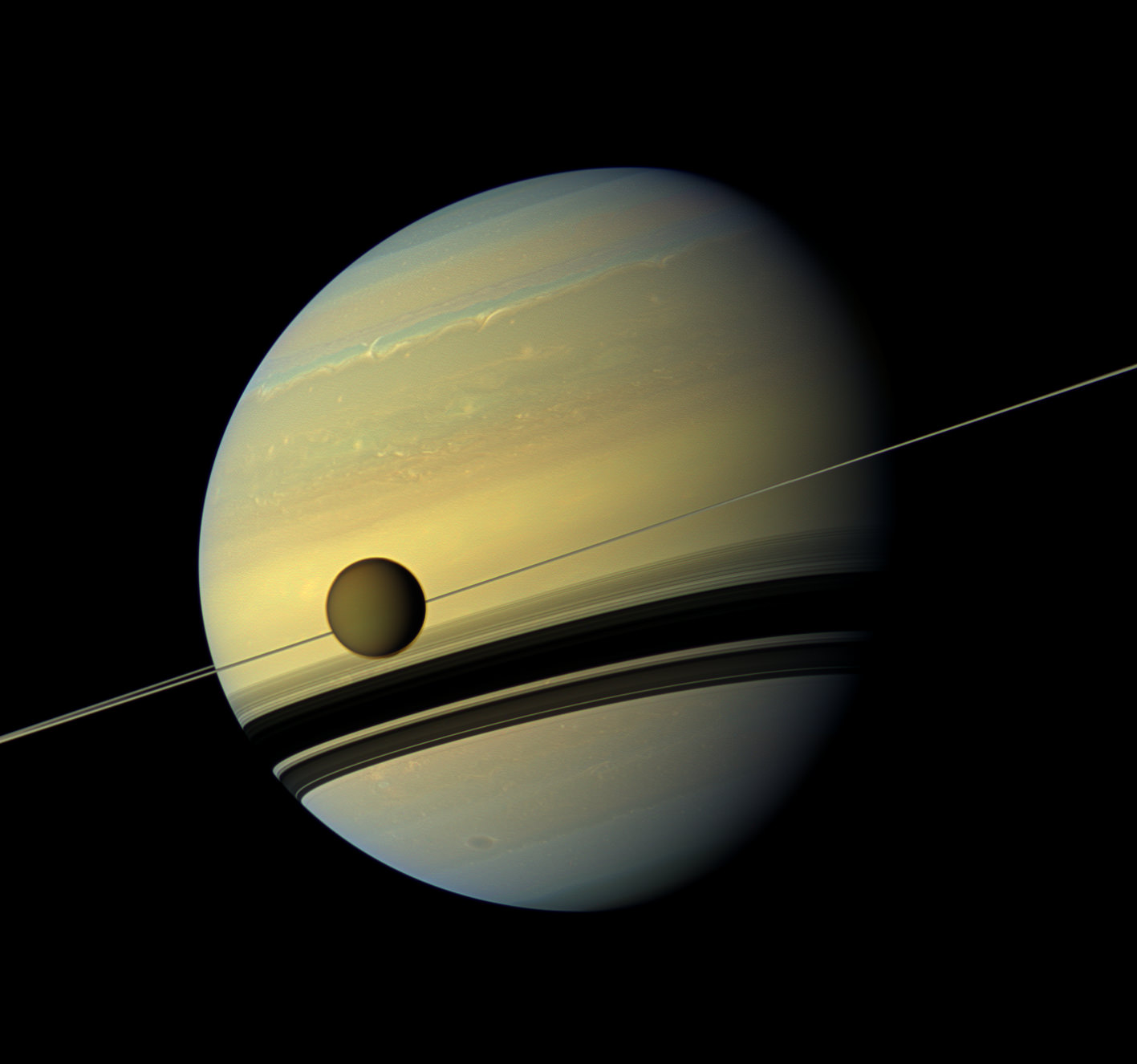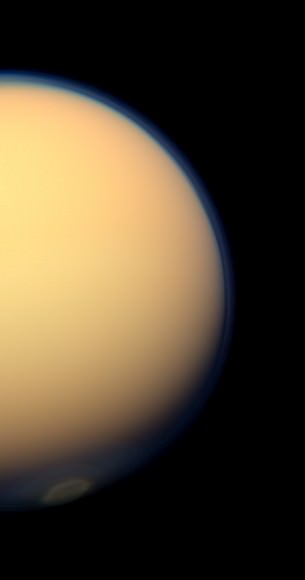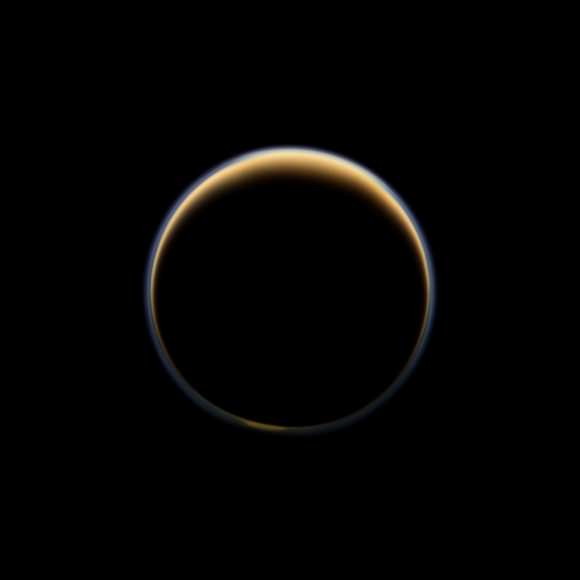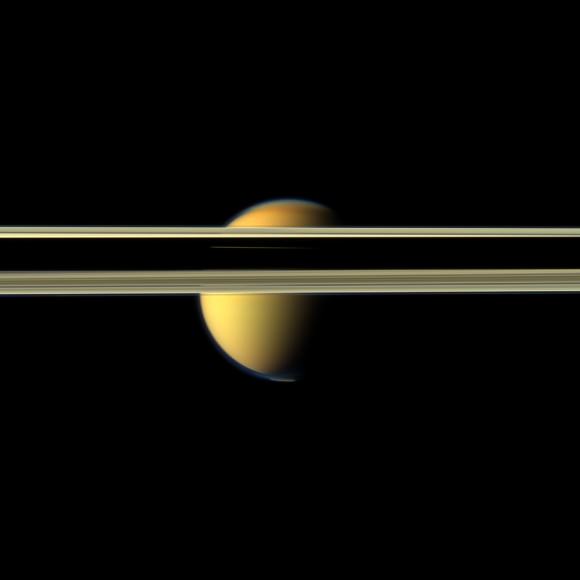It’s cold right now. Okay, fine, here on Vancouver Island, it’s actually pretty warm. But for the rest of Canada and big parts of the US, it’s terrifyingly cold. Colder than Mars or the North Pole cold. This is all thanks to the break up of the polar vortex. What are polar vertices, how do they form, and where else to we find them in the Solar System?
What Did Cassini Teach Us?
Ask me my favorite object in the Solar System, especially to see through a telescope, and my answer is always the same: Saturn.
Saturn is this crazy, ringed world, different than any other place we’ve ever seen. And in a small telescope, you can really see the ball of the planet, you can see its rings. It’s one thing to see a world like this from afar, a tiny jumping image in a telescope. To really appreciate and understand a place like Saturn, you’ve got to visit.
And thanks to NASA’s Cassini spacecraft, that’s just what we’ve been doing for the last 13 years. Take a good close look at this amazing ringed planet and its moons, and studying it from every angle.
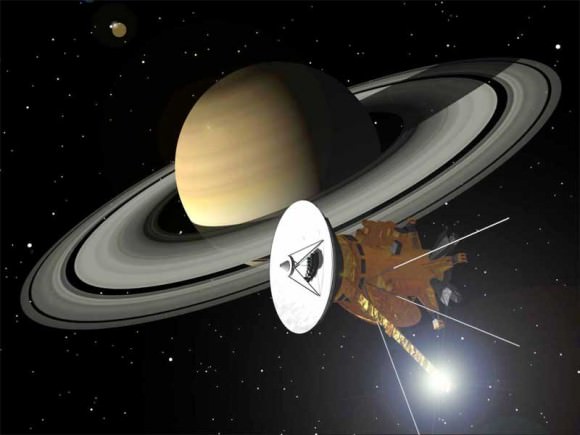
Throughout this article, I’m going to regale you with the amazing discoveries made by Cassini at Saturn. What it taught us, and what new mysteries it uncovered.
NASA’s Cassini spacecraft was launched from Earth on October 15, 1997. Instead of taking the direct route, it made multiple flybys of Venus, a flyby of Earth and a flyby of Jupiter. Each one of these close encounters boosted Cassini’s velocity, allowing it to make the journey with less escape velocity from Earth.
It arrived at Saturn on July 1st, 2004 and began its science operations shortly after that. The primary mission lasted 4 years, and then NASA extended its mission two more times. The first ending in 2010, and the second due to end in 2017. But more on that later.
Before Cassini, we only had flybys of Saturn. NASA’s Pioneer 11, and Voyagers 1 and 2 both zipped past the planet and its moons, snapping pictures as they went.
But Cassini was here to stay. To orbit around and around the planet, taking photos, measuring magnetic fields, and studying chemicals.
For Saturn itself, Cassini was able to make regular observations of the planet as it passed through entire seasons. This allowed it to watch how the weather and atmospheric patterns changed over time. The spacecraft watched lightning storms dance through the cloudtops at night.
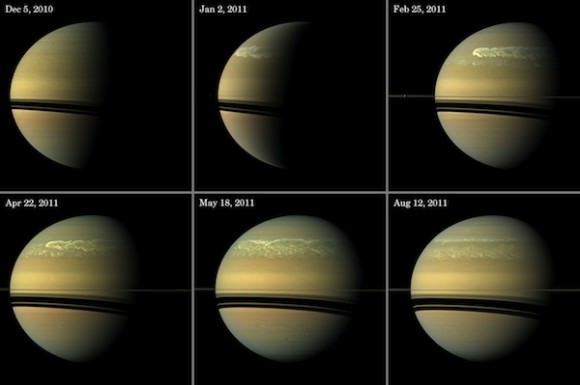
Two highlights. In 2010, Cassini watched a huge storm erupt in the planet’s northern hemisphere. This storm dug deep into Saturn’s lower atmosphere, dredging up ice from a layer 160 kilometers below and mixing it onto the surface. This was the first time that astronomers were able to directly study this water ice on Saturn, which is normally in a layer hidden from view.
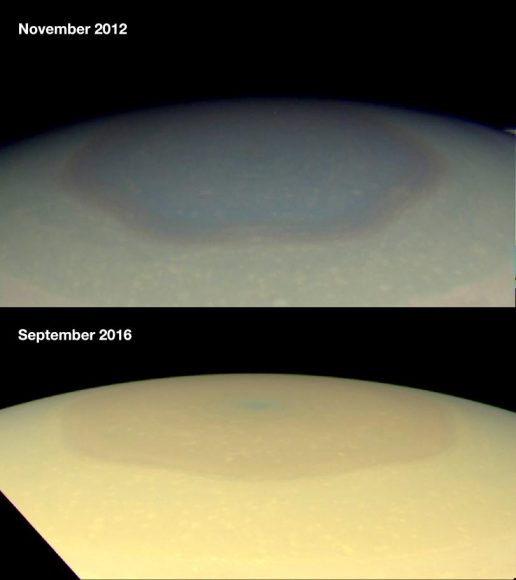
The second highlight, of course, is the massive hexagonal storm churning away in Saturn’s northern pole. This storm was originally seen by Voyager, but Cassini brought its infrared and visible wavelength instruments to bear.
Why a hexagon? That’s still a little unclear, but it seems like when you rotate fluids of different speeds, you get multi-sided structures like this.
Cassini showed how the hexagonal storm has changed in color as Saturn moved through its seasons.
This is one of my favorite images sent back by Cassini. It’s the polar vortex at the heart of the hexagon. Just look at those swirling clouds.
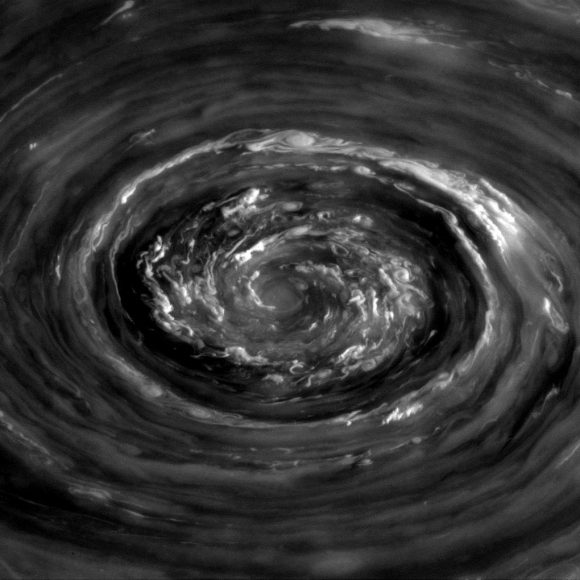
Now, images of Saturn itself are great and all, but there was so much else for Cassini to discover in the region.
Cassini studied Saturn’s rings in great detail, confirming that they’re made up of ice particles, ranging in size as small a piece of dust to as large as a mountain. But the rings themselves are actually quite thin. Just 10 meters thick in some places. Not 10 kilometers, not 10 million kilometers, 10 meters, 30 feet.
The spacecraft helped scientists uncover the source of Saturn’s E-ring, which is made up of fresh icy particles blasting out of its moon Enceladus. More on that in a second too.
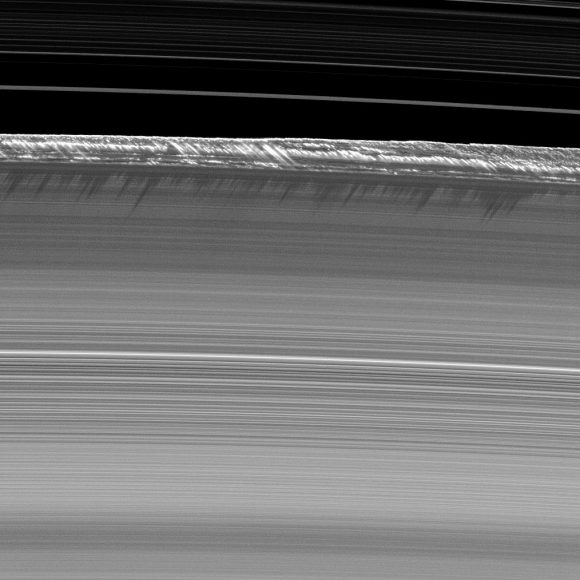
Here’s another one of my favorite images of the mission. You’re looking at strange structures in Saturn’s B-ring. Towering pillars of ring material that rise 3.5 kilometers above the surrounding area and cast long shadows. What is going on here?
They’re waves, generated in the rings and enhanced by nearby moons. They move and change over time in ways we’ve never been able to study anywhere else in the Solar System.
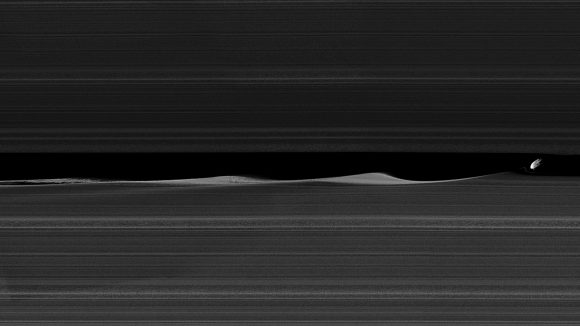
Cassini has showed us that Saturn’s rings are a much more dynamic place than we ever thought. Some moons are creating rings, other moons are absorbing or distorting them. The rings generate bizarre spoke patterns larger than Earth that come and go because of electrostatic charges.
Speaking of moons, I’m getting to the best part. What did Cassini find at Saturn’s moons?
Let’s start with Titan, Saturn’s largest moon. Before Cassini, we only had a few low resolution images of this fascinating world. We knew Titan had a dense atmosphere, filled with nitrogen, but little else.
Cassini was carrying a special payload to assist with its exploration of Titan: the Huygens lander. This tiny probe detached from Cassini just before its arrival at Saturn, and parachuted through the cloudtops on January 14, 2005, analyzing all the way. Huygens returned images of its descent through the atmosphere, and even images of the freezing surface of Titan.
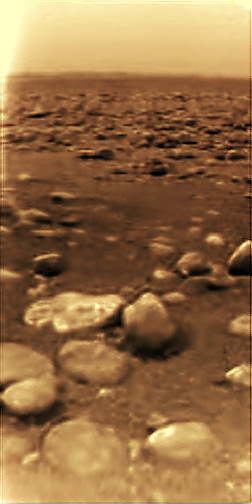
But Cassini’s own observations of Titan took the story even further. Instead of a cold, dead world, Cassini showed that it has active weather, as well as lakes, oceans and rivers of hydrocarbons. It has shifting dunes of pulverized rock hard water ice.
If there’s one place that needs exploring even further, it’s Titan. We should return with sailboats, submarines and rovers to better explore this amazing place.
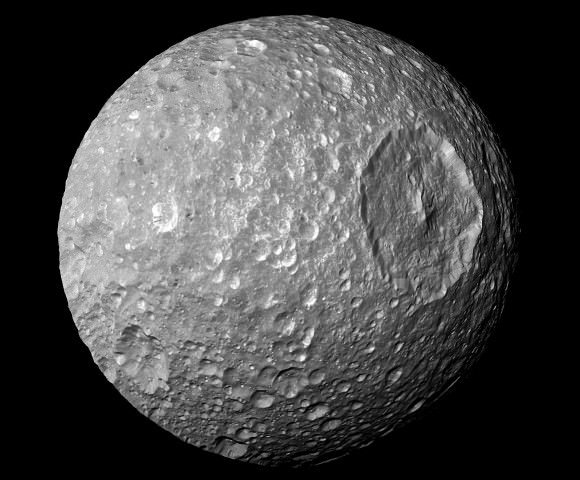
We learned, without a shadow of a doubt, that Mimas absolutely looks like the Death Star. No question. But instead of a megalaser, this moon has a crater a third of its own size.
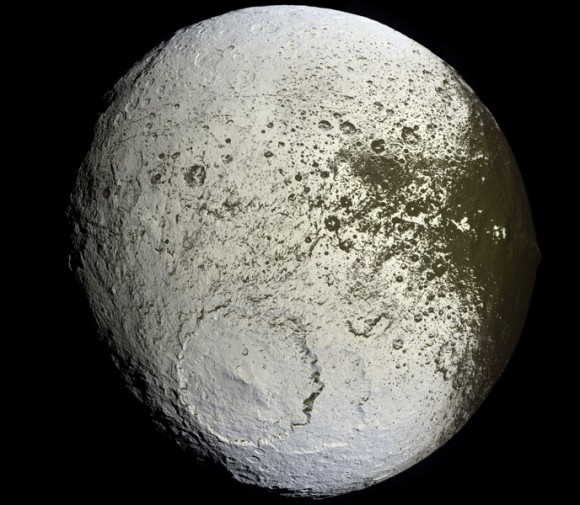
Cassini helped scientists understand why Saturn’s moon Iapetus has one light side and one dark side. The moon is tidally locked to Saturn, its dark side always leading the moon in orbit. It’s collecting debris from another Saturnian moon, Phoebe, like bugs hitting the windshield of a car.
Perhaps the most exciting discovery that Cassini made during its mission is the strange behavior of Saturn’s moon Enceladus. The spacecraft discovered that there are jets of water ice blasting out of the moon’s southern pole. An ocean of liquid water, heated up by tidal interactions with Saturn, is spewing out into space.
And as you know, wherever we find water on Earth, we find life. We thought that water in the icy outer Solar System would be hard to reach, but here it is, right at the surface, venting into space, and waiting for us to come back and investigate it further.
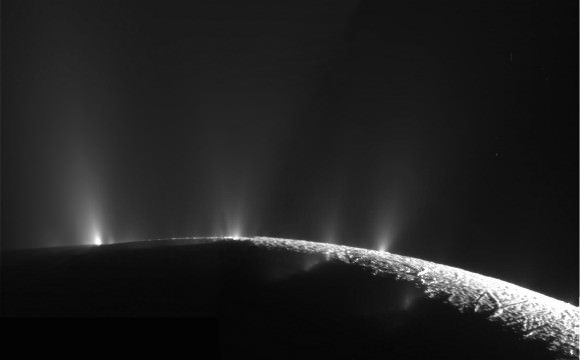
On September 15, 2017, the Cassini mission will end. How do we know it’s going to happen on this exact date? Because NASA is going to crash the spacecraft into Saturn, killing it dead.
That seems a little harsh, doesn’t it, especially for a spacecraft which has delivered so many amazing images to us over nearly two decades of space exploration? And as we’ve seen from NASA’s Opportunity rover, still going, 13 years longer than anticipated. Or the Voyagers, out in the depths of the void, helping us explore the boundary between the Solar System and interstellar space. These things are built to last.
The problem is that the Saturnian system contains some of the best environments for life in the Solar System. Saturn’s moon Enceladus, for example, has geysers of water blasting out into space.
Cassini spacecraft is covered in Earth-based bacteria and other microscopic organisms that hitched a ride to Saturn, and would be glad to take a nice hot Enceladian bath. All they need is liquid water and a few organic chemicals to get going, and Enceladus seems to have both.
NASA feels that it’s safer to end Cassini now, when they can still control it, than to wait until they lose communication or run out of propellant in the future. The chances that Cassini will actually crash into an icy moon and infect it with our Earth life are remote, but why take the risk?
For the last few months, Cassini has been taking a series of orbits to prepare itself for its final mission. Starting in April, it’ll actually cross inside the orbit of the rings, getting closer and closer to Saturn. And on September 15th, it’ll briefly become a meteor, flashing through the upper atmosphere of Saturn, gone forever.
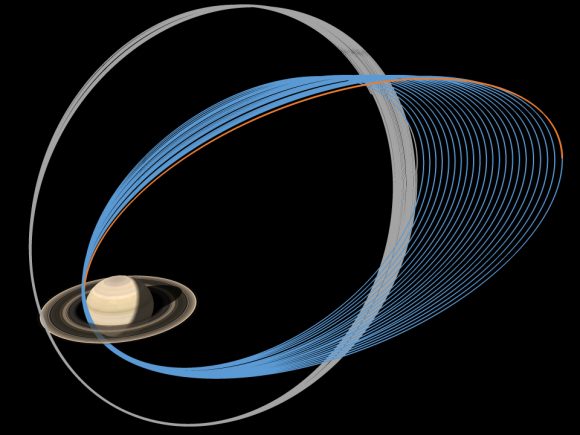
Even in its final moments, Cassini is going to be sciencing as hard as it can. We’ll learn more about the density of consistency of the rings close to the planet. We’ll learn more about the planet’s upper atmosphere, storms and clouds with the closest possible photographs you can take.
And then it’ll all be over. The perfect finale to one of the most successful space missions in human history. A mission that revealed as many new mysteries about Saturn as it helped us answer. A mission that showed us not only a distant alien world, but our own planet in perspective in this vast Solar System. I can’t wait to go back.
How have the photos from Cassini impacted your love of astronomy? Let me know your thoughts in the comments.
Seasonal Change On Titan Is Dynamic Business
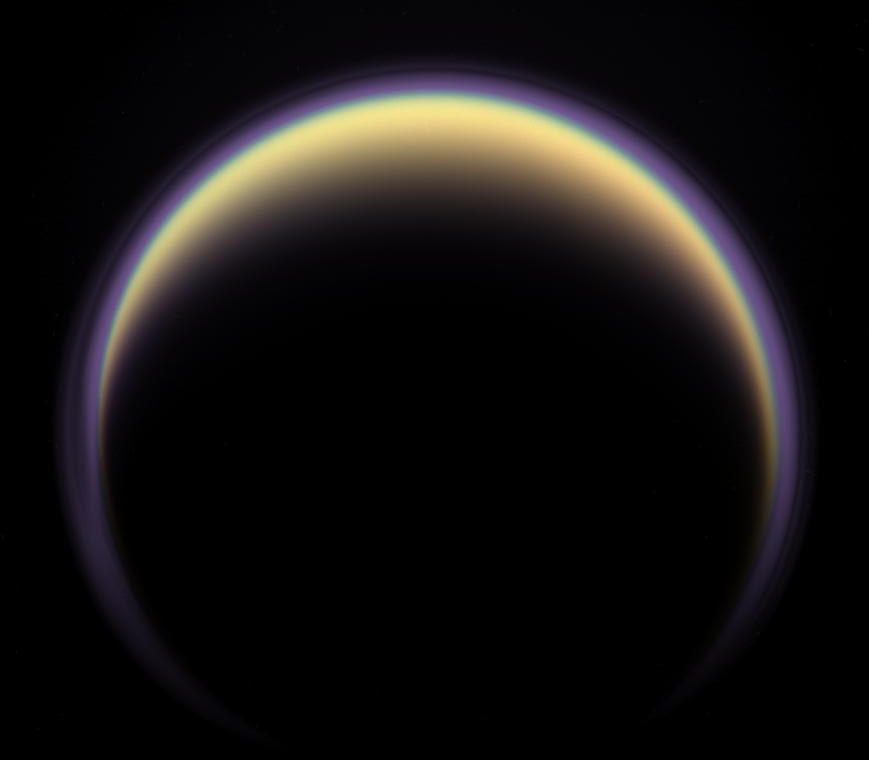
Ever since the Cassini probe arrived at Saturn in 2004, it has revealed some startling things about the planet’s system of moons. Titan, Saturn’s largest moon, has been a particular source of fascination. Between its methane lakes, hydrocarbon-rich atmosphere, and the presence of a “methane cycle” (similar to Earth’s “water cycle”), there is no shortage of fascinating things happening on this Cronian moon.
As if that wasn’t enough, Titan also experiences seasonal changes. At present, winter is beginning in the southern hemisphere, which is characterized by the presence of a strong vortex in the upper atmosphere above the south pole. This represents a reversal of what the Cassini probe witnessed when it first started observing the moon over a decade ago, when similar things were happening in the northern hemisphere.
These finding were shared at the joint 48th meeting of the American Astronomical Society’s Division for Planetary Sciences and 11th European Planetary Science Congress, which took place from Oct 16th to 21st in Pasadena, California. As the second joint conference between these bodies, the goal of this annual meeting is to strengthen international scientific collaboration in the field of planetary science.
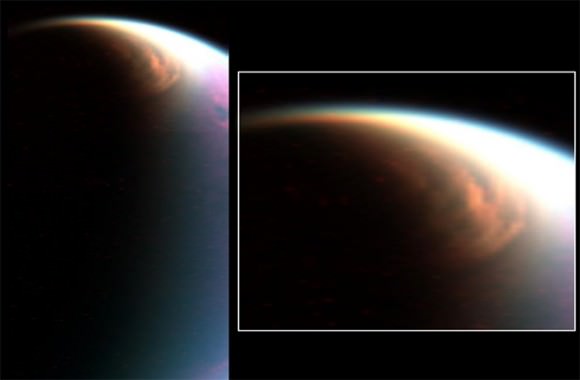
During the course of the meeting, Dr. Athena Coustenis – the Director of Research (1st class) with the National Center for Scientific Research (CNRS) in France – shared the latest atmospheric data retrieved by Cassini. As she stated:
“Cassini’s long mission and frequent visits to Titan have allowed us to observe the pattern of seasonal changes on Titan, in exquisite detail, for the first time. We arrived at the northern mid-winter and have now had the opportunity to monitor Titan’s atmospheric response through two full seasons. Since the equinox, where both hemispheres received equal heating from the Sun, we have seen rapid changes.”
Scientists have been aware of seasonal change on Titan for some time. This is characterized by warm gases rising at the summer pole and cold gases settling down at the winter pole, with heat being circulated through the atmosphere from pole to pole. This cycle experiences periodic reversals as the seasons shift from one hemisphere to the other.
In 2009, Cassini observed a large scale reversal immediately after the equinox of that year. This led to a temperature drop of about 40 °C (104 °F) around the southern polar stratosphere, while the northern hemisphere experienced gradual warming. Within months of the equinox, a trace gas vortex appeared over the south pole that showed glowing patches, while a similar feature disappeared from the north pole.
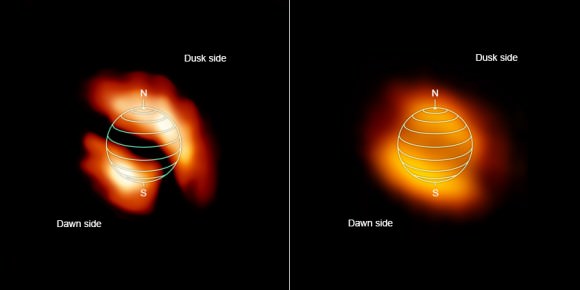
A reversal like this is significant because it gives astronomers a chance to study Titan’s atmosphere in greater detail. Essentially, the southern polar vortex shows concentrations of trace gases – like complex hydrocarbons, methylacetylne and benzene – which accumulate in the absence of UV light. With winter now upon the southern hemisphere, these gases can be expected to accumulate in abundance.
As Coustenis explained, this is an opportunity for planetary scientists to test out their models for Titan’s atmosphere:
“We’ve had the chance to witness the onset of winter from the beginning and are approaching the peak time for these gas-production processes in the southern hemisphere. We are now looking for new molecules in the atmosphere above Titan’s south polar region that have been predicted by our computer models. Making these detections will help us understand the photochemistry going on.”
Previously, scientists had only been able to observe these gases at high northern latitudes, which persisted well into summer. They were expected to undergo slow photochemical destruction, where exposure to light would break them down depending on their chemical makeup. However, during the past few months, a zone of depleted molecular gas and aerosols has developed at an altitude of between 400 and 500 km across the entire northern hemisphere .
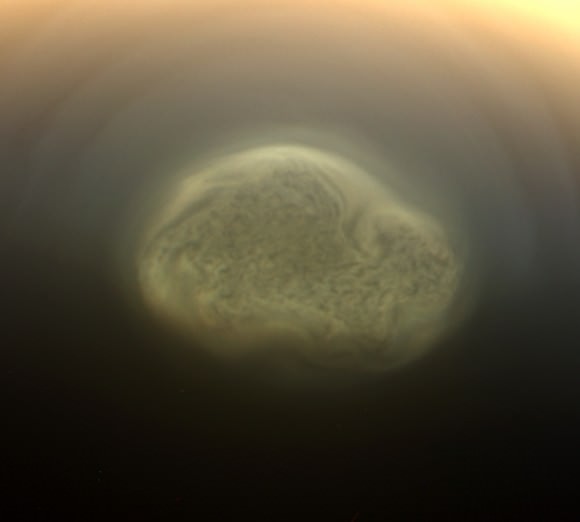
This suggests that, at high altitudes, Titan’s atmosphere has some complex dynamics going on. What these could be is not yet clear, but those who have made the study of Titan’s atmosphere a priority are eager to find out. Between now and the end of Cassini mission (which is slated for Sept. 2017), it is expected that the probe will have provided a complete picture of how Titan’s middle and upper atmospheres behave.
By mission’s end, the Cassini space probe will have conducted more than 100 targeted flybys of Saturn. In so doing, it has effectively witnessed what a full year on Titan looks like, complete with seasonal variability. Not only will this information help us to understand the deeper mysteries of one of the Solar System’s most mysterious moons, it should also come in handy if and when we send astronauts (and maybe even settlers) there someday!
Further Reading: Europlanet
Changing Hues Signal Transition of Seasons at Saturn
The giant moon Titan passes in front of Saturn in this natural-color, wide-angle view from NASA’s Cassini spacecraft. Image Credit: NASA/JPL-Caltech/SSI
[SPOILER ALERT: Viewing these images will force you to change your computer wallpaper]
Here on Earth, it’s almost time for the burst of fall color that signals the change of seasons in the Northern Hemisphere. Saturn’s color too is transforming subtly as the gas giant slips into a Saturnian spring and autumn as seen in this series of true-color images from NASA’s Cassini spacecraft.
Titan, a moon larger than the planet Mercury, hangs before the rings and changing colors of Saturn in the first of four spectacular images release by NASA and the Cassini Imaging Central Laboratory for Operations (CICLOPS).
“For no other reason than that they are gorgeous, the Cassini imaging team is releasing today a set of fabulous images of Saturn and Titan…in living color…for your day-dreaming enjoyment,” said Carolyn Porco, Cassini imaging team lead based at the Space Science Institute in Boulder, Colordo, in an email blast.
When Cassini arrived at Saturn eight years ago, the planet’s northern hemisphere, locked in winter, showed azure blue. Now as winter passes to the southern hemisphere, the colors are reversing as the blue fades from the north and rises in the south.
“Note that our presence at Saturn for the last eight years has made possible the sighting of subtle changes with time, and one such change is obvious here,” Porco said. “As the seasons have advanced, and spring has come to the north and autumn to the south throughout the Saturn system, the azure blue in the northern winter Saturnian hemisphere that greeted Cassini upon its arrival in 2004 is now fading; and it is now the southern hemisphere, in its approach to winter, that is taking on a bluish hue.”
Scientists believe that the increasing blue color in the south likely is due to the increasing intensity of ultraviolet light from the Sun which produces the haze. Methane in the atmosphere also absorbs light toward the red end of the spectrum while reflecting blue light. This view looks from just above the ring plane with the Sun shining from above casting broad shadows on the colorful clouds of Saturn. The image was taken on May 6, 2012 from about 778,000 kilometers (483,000 miles) from Titan.
Some of the views, including this image of a vortex at Titan’s south pole are only possible because of a newly tilted, or inclined, orbit that takes Cassini high over the poles of Saturn and its moons. Scientists first noticed the detached mass of clouds over the south pole in March. The swirling mass of the vortex stands out clearly against the golden cloud deck surrounding Titan.
The recently formed south polar vortex stands out against Titan in this natural-color view from NASA’s Cassini spacecraft. Image Credit: NASA/JPL-Caltech/SSI
Sunlight scattering through Titan’s atmosphere forms a ring of color as NASA’s Cassini spacecraft cruises along the night side of Saturn’s largest moon. Image Credit: NASA/JPL-Caltech/SSI
A glowing hint of the polar vortex shows in this image looking toward the night-time, Saturn-facing side of Titan. Sunlight scattering through Titan’s atmosphere forms the ring of color in this image taken about 216,000 kilometers (134,000 miles) from Titan.
Saturn’s rings cut colorful Titan in half in this image from NASA’s Cassini spacecraft. Image Credit: NASA/JPL-Caltech/SSI
The rings obscure Titan in the final image of the quartet. The image is taken from just above the northern, sunlit side of the ring plane. Saturn’s shadow cast along the rings create the dark swath in the center of the image but if you look close, you can see a tiny sliver of Titan through the Cassini Division, the largest gap in Saturn’s wide rings.
“Cassini has been in orbit now for the last eight years, and despite the fact that we can’t know exactly what the next five years will show us, we can be certain that whatever it is will be wondrous,” said Porco.
About the author: John Williams is owner of TerraZoom, a Colorado-based web development shop specializing in web mapping and online image zooms. He also writes the award-winning blog, StarryCritters, an interactive site devoted to looking at images from NASA’s Great Observatories and other sources in a different way. A former contributing editor for Final Frontier, his work has appeared in the Planetary Society Blog, Air & Space Smithsonian, Astronomy, Earth, MX Developer’s Journal, The Kansas City Star and many other newspapers and magazines.


